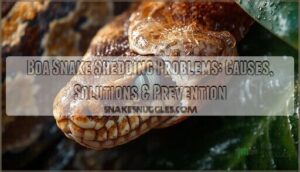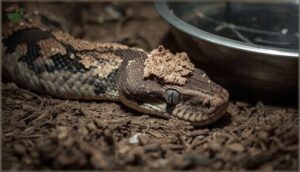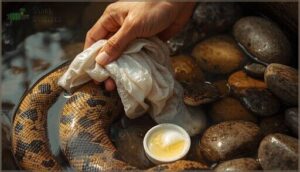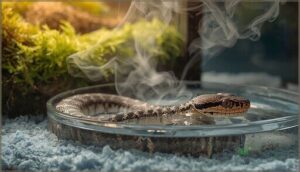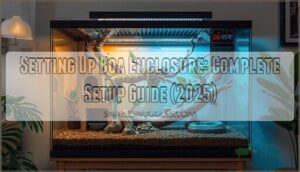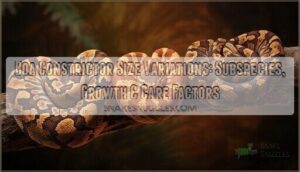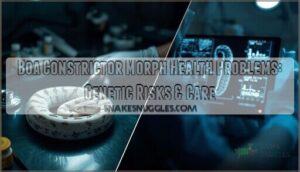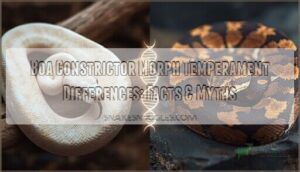This site is supported by our readers. We may earn a commission, at no cost to you, if you purchase through links.
Your boa’s eyes cloud over with that distinctive milky-blue haze, signaling a shed is coming. But when the process finishes, you notice something’s wrong—patches of old skin cling stubbornly to the body, or worse, the eyecaps haven’t come off at all.
These boa snake shedding problems aren’t just cosmetic issues. Retained shed can restrict blood flow, trap bacteria against the skin, and in severe cases, lead to infections or even vision loss. The culprit is usually straightforward: humidity levels that looked fine on paper but didn’t match what your snake actually needed during this vulnerable window.
Understanding the difference between a healthy, complete shed and one that’s gone sideways means you can step in early, identify the source, and help your boa through the process safely.
Table Of Contents
Key Takeaways
- Retained shed in boas—often showing as stuck eyecaps or patchy skin—typically stems from humidity levels below 70-75% during shedding, and can lead to infections, blood flow restriction, or vision loss if left untreated.
- You can safely address stuck shed at home through lukewarm soaks (80-86°F for 10-20 minutes), humidity chambers with damp moss maintaining 80-85% humidity, and gentle assistance with damp cloths—but persistent issues after three consecutive sheds require veterinary intervention.
- Prevention hinges on maintaining humidity between 55-75% normally and boosting to 75-85% during active shedding, combined with proper temperature gradients (85-90°F basking, 75-80°F cool zone) and moisture-retaining substrates like coconut husk or cypress mulch.
- Warning signs demanding immediate vet care include pus-filled blisters, foul-smelling lesions, respiratory symptoms like wheezing, or shedding problems persisting beyond three cycles despite corrected environmental conditions—as these often indicate bacterial infections, parasites, or metabolic disorders.
Recognizing Boa Shedding Problems
Knowing when your boa’s shed is going sideways can save you from bigger headaches down the road. A healthy shed happens in one clean piece, but when things go wrong, you’ll see telltale signs that demand attention.
Let’s walk through what normal shedding looks like versus the red flags that signal trouble.
Signs of Normal Vs. Problematic Shedding
You’ll know a normal shed when your boa’s eyes turn milky blue 7-10 days before shedding, then clear up as the skin comes off in one complete piece.
Problematic shed indicators include patchy pieces, retained eyecaps, or skin stuck on tail tips. Watch for incomplete shedding over several days—that’s when identifying shedding issues becomes critical to prevent infections.
Low humidity can be a factor in causing shedding problems.
Common Symptoms of Shedding Issues
When your boa’s dealing with shedding problems, you’ll notice skin texture turning saggy around the head and neck—not just during the “cloudy eyes” phase, but lingering afterward. Color changes become extreme, with wrinkled skin persisting days past normal shed duration.
Behavioral signs like hiding, lethargy, or snapping at you signal distress. Health symptoms include stuck shed patches and skin abnormalities that won’t resolve on their own.
Proper humidity and temperature control are essential to prevent future skin shedding issues.
Identifying Stuck Shed and Retained Eyecaps
After shedding, you’ll want to examine your boa carefully for visual indicators like dry patches or confetti-like pieces scattered around the enclosure. Check if both eyecaps came off—retained eyecaps look cloudy and grainy.
Environmental clues matter too: low humidity often causes these shedding problems.
Post-shed checks help catch stuck shed early, especially around the tail tip and eyes, preventing future complications.
Causes of Shedding Difficulties in Boas
When your boa struggles to shed properly, it’s usually telling you something’s off in their environment or health. Most shedding problems trace back to a handful of fixable issues, from humidity levels that are too low to underlying health conditions you mightn’t have noticed yet.
Let’s look at the main culprits behind difficult sheds so you can pinpoint what’s going wrong.
Inadequate Humidity and Temperature
When environmental factors slip out of balance, your boa’s shedding cycle can go sideways fast. Low humidity and temperature control issues account for nearly half of all shedding problems in captive boas. Here’s what you need to watch:
- Humidity levels should hover between 55-75%, jumping to 85% during active shedding
- Temperature gradients must range from 90-95°F (warm end) to 75-80°F (cool end)
- Substrate moisture retention prevents dehydration during ecdysis
- Misting systems boost enclosure humidity by 20-25% when timed properly
- Thermal stress from unregulated heat sources increases complications by 37%
Inadequate humidity below 50% causes incomplete sheds and retained eyecaps in up to 60% of cases. Meanwhile, maintaining proper humidity with consistent monitoring reduces shedding issues by 25%.
Heat mats without humidity control can dry out your snake even when ambient readings look fine, so check those environmental factors regularly.
Poor Substrate and Enclosure Setup
Your snake’s living space can make or break a successful shed. Substrate options like coconut fiber and cypress mulch retain moisture and help regulate enclosure humidity, while sand and crushed walnut shell increase substrate impaction risk and shedding failures.
Enclosure size also plays a crucial role—cramped quarters can restrict movement and stress your boa.
Biosecurity importance and substrate maintenance are essential; weekly deep cleaning helps prevent infections that can complicate sheds.
Health Issues Affecting Shedding
Underlying medical conditions often sabotage what should be a straightforward process. Health problems and shedding are closely linked through several mechanisms:
- Scale rot and skin infections: Bacterial or fungal infections create damaged tissue that won’t release properly
- Mite infestations and shedding: Parasites cause irritation and secondary skin damage
- Retained eyecaps: Result from dysecdysis causes like chronic dehydration
- Respiratory infections in boas: Systemic illness triggers shedding stress and incomplete cycles
Dietary and Nutritional Factors
What your boa eats directly shapes skin health and shedding success. Protein needs around 50-60% support tissue development, while inadequate fat intake reduces skin pliability. Vitamin A deficiencies cause retained eyecaps, yet excess triggers ulceration. Mineral imbalance, especially calcium-phosphorus ratios, disrupts keratinization.
Erratic feeding slows epidermal turnover, making dietary mistakes and shedding closely intertwined. A balanced diet with proper prey composition and consistent food intake prevents most nutritional shedding problems.
Addressing Stuck Shed and Incomplete Shedding
When your boa has stuck shed, you need to act quickly but carefully to avoid damaging the skin underneath. The good news is that most cases respond well to simple at-home treatments that focus on moisture and gentle assistance.
Let’s walk through the safest, most effective methods to help your snake shed completely and comfortably.
Safe Methods to Remove Stuck Shed
When you’re removing stuck shed, think of it as peeling a delicate label—patience wins. Gentle lukewarm soaks soften the old skin first, then use damp washcloths to wipe along the scales. Natural oils like coconut can ease stubborn patches.
A humid hide lets your boa work it off naturally.
Eye cap removal needs extra care under veterinary supervision, with repetition protocols if needed.
Using Soaks and Humidity Chambers
Gentle lukewarm soaks at 80°F–86°F for 10–20 minutes soften retained skin effectively, helping your boa with stuck shed. Daily soaks resolve 85% of cases within two to three sessions.
Chamber placement on the cool side with damp moss maintains 80%–85% humidity levels without overheating.
Watch for veterinary signs like persistent retention—excess humidity risks infections, so balance is key for snake skin hydration.
Eye Cap and Tail Tip Removal Techniques
When retained eye caps or tail tip constriction threaten your boa’s health, safe removal tools and preventative measures matter. Within 24 hours of shedding, veterinary intervention ensures success rates above 80% for stuck shed:
- Apply saline drops for 60 minutes before removing stuck shed
- Use adhesive tape—not forceps—for eye cap safety
- Loosen tail tip shed gently with dampened fingernails
- Seek professional help if multiple layers remain
Preventing Future Shedding Problems
Once you’ve tackled a shedding problem, the goal shifts to making sure it doesn’t happen again. Prevention comes down to getting the basics right—humidity, temperature, substrate, diet, and keeping stress low.
Let’s walk through the key factors that’ll help your boa shed cleanly every time.
Maintaining Optimal Humidity and Temperature
To keep your boa shedding smoothly, you’ll need to dial in both humidity and temperature control. During sheds, boost humidity levels to 75-85% using misting or damp hides, while normal conditions stay around 55-75%. Temperature gradients matter too—maintain a basking spot at 85-90°F with a cooler zone at 75-80°F. Digital hygrometers and thermometers guarantee accurate environmental conditions monitoring.
| Parameter | Normal Range | During Shedding |
|---|---|---|
| Humidity | 55-75% | 75-85% |
| Basking Spot | 85-90°F | 85-90°F |
| Cool Zone | 75-80°F | 75-80°F |
| Monitoring Tool | Digital hygrometer | Digital hygrometer |
| Ventilation Needs | Moderate airflow | Moderate airflow |
Substrate moisture and proper ventilation work together with these ranges. Seasonal adjustments may be needed as your home’s climate shifts throughout the year.
Proper Substrate Selection and Enclosure Maintenance
Your substrate selection for snakes goes hand-in-hand with humidity control. Naturalistic blends—like 40% topsoil, 40% ReptiSoil, and 20% play sand—offer optimal humidity levels without impaction risks. For bioactive benefits, these setups can last years with proper cleaning frequency. Daily spot-cleaning and monthly deep substrate hygiene prevent infections while supporting healthy shedding cycles in your boa’s enclosure maintenance routine.
- Use at least 2 inches of moisture-retaining substrate like coconut husk or cypress mulch
- Add sphagnum moss or leaf litter on top for extra humidity control
- Spot-clean daily and replace substrate completely every 4–6 weeks
- Avoid sand, reptile carpet, pine, or cedar due to health risks
- Disinfect all enclosure accessories monthly to reduce bacterial buildup
Stress Reduction and Routine Monitoring
Beyond physical habitat optimization, your boa’s emotional environment matters just as much. Stress monitoring through weekly behavioral checks catches 90% of health issues early. Consistent, calm handling during regular shedding cycles builds trust—boas handled gently show 45% fewer defensive reactions. Environmental enrichment, like familiar hides, reduces stress behaviors by 60%, making preventative measures against shedding problems far more effective.
| Stress Indicator | What It Means |
|---|---|
| Extended hiding (24+ hours) | Signals physiological stress in 65% of cases |
| Reduced tongue flicking | Early warning before 80% of shedding issues |
| Weight loss over 10% per cycle | Indicates husbandry-related environmental factors |
Nutrition for Healthy Skin and Shedding
Proper nutrition builds skin resilience from the inside out. A balanced diet of appropriately sized frozen rodents delivers essential vitamins that support smooth, complete sheds. Dietary variety ensures thorough micronutrient intake, while vitamin supplementation—especially calcium and D3—prevents deficiencies that cause retained skin.
- Feed juveniles weekly, adults every 1-2 weeks based on body condition
- Match prey size to your boa’s mid-body diameter to avoid metabolic stress
- Provide fresh water daily; hydration importance can’t be overstated for skin elasticity
- Avoid malnourished prey animals that trigger nutritional “save mode” and irregular shedding
When to Seek Veterinary Help
Most shedding problems clear up with a humidity boost and a warm soak, but sometimes your boa needs professional help. Knowing when to pick up the phone can mean the difference between a quick fix and a serious health crisis.
Most shedding issues resolve with humidity and soaks, but knowing when to call a vet can prevent a crisis
Let’s look at the red flags that signal it’s time to call your reptile vet.
Signs of Infection or Severe Complications
When your boa’s shedding problems spiral beyond simple stuck skin, you need to act fast. Bacterial skin infections show up as red, swollen lesions with pus-filled blisters—sometimes with a foul smell. Watch for abnormal skin discoloration, mouth sores, or neurological abnormalities like unusual posture. Respiratory signs include nasal discharge and wheezing sounds.
| Physical Signs | Infection Symptoms | Severe Complications |
|---|---|---|
| Pus-filled blisters, swelling | Bacterial skin infections | Septicemia (bloodstream infection) |
| Red inflamed patches | Fungal infections, lesions | Scale rot, open ulcers |
| Milky, opaque eyes | Retained eyecaps causing blindness | Vision impairment, stress |
| Nasal discharge, bubbles | Respiratory infection (wheezing) | Chronic respiratory distress |
| Lethargy, appetite loss | Stomatitis (mouth infection) | Potential death within days |
Clinical approaches include bacterial cultures and blood tests to check for systemic infection. Measurable impacts matter: untreated septicemia can kill within days, while antibiotic treatment generally runs 2-4 weeks. Seek veterinary care immediately if you spot these warning signs.
Persistent Shedding Problems
When shedding frequency climbs beyond the typical four to nine cycles annually, or behavioral changes persist for weeks, veterinary intervention becomes critical. Chronic dysecdysis—that’s persistent skin problems—rarely resolves with just humidity tweaks. Your vet can pinpoint whether heat sources are drying your boa, if vitamin imbalance is disrupting skin regeneration, or if mite infestation demands aggressive treatment options.
Consider professional shed removal if:
- Retained skin appears after three consecutive sheds despite environmental corrections
- Eye caps remain stuck through multiple shedding cycles
- Skin tears or bleeds during home treatment attempts
- Systemic signs like lethargy accompany incomplete sheds
Treating shedding problems sometimes requires prescription topicals, nutritional supplements, or manual removal under controlled conditions—interventions you can’t safely replicate at home.
Underlying Health Conditions Affecting Shedding
When your boa struggles to shed despite ideal conditions, deeper problems may lurk beneath the surface. Parasite infestations, fungal infections, and internal parasites compromise health status and disrupt normal skin turnover.
Nutritional deficiencies—especially Vitamin A imbalances—trigger metabolic disorders that make clean sheds nearly impossible.
IBD impact remains particularly devastating, causing neurological decline alongside chronic shedding failure that signals the disease’s irreversible progression.
Frequently Asked Questions (FAQs)
How often do healthy boas shed naturally?
Young boas generally shed every 4-8 weeks due to rapid growth, while adults shed approximately four to five times yearly.
Shedding frequency depends on diet, temperature, and individual health—each snake’s cycle varies naturally.
Can stress alone cause shedding problems?
While stress rarely acts alone, it amplifies shedding problems by disrupting hormones and behaviors. Captivity stressors plus poor husbandry create a perfect storm.
Husbandry improvements targeting environmental stress are essential for preventing shedding issues altogether.
Do different boa species have different shedding needs?
Yes—habitat humidity, substrate differences, and dietary needs vary by species. Boa constrictors need 70% humidity during shedding, while rainforest species require 80%.
These genetic factors directly influence shedding frequency and reptile care requirements.
What humidity level is best during pre-shed?
I once treated a boa whose eyes looked cloudy for weeks—turned out the enclosure humidity hovered at 45%.
Proper humidity during pre-shed sits between 70-80%, supporting complete skin release and preventing stuck eyecaps.
Should I handle my boa during shedding?
It’s best to avoid handling your boa during shedding, especially during the blue-eye phase. Handling risks stress and defensive behavior.
Minimal handling prevents injuries and shedding problems—expert advice favors patience over intervention.
Conclusion
A single overlooked shed can spiral into a cascade of complications faster than you’d think. But now you’ve got the tools to spot trouble early, adjust conditions precisely, and intervene safely when boa snake shedding problems arise.
Monitor humidity religiously, inspect every shed cycle, and trust your instincts when something feels off. Your boa depends on you to catch what it can’t communicate—and with this knowledge, you’re more than ready to deliver.
- https://www.boa-constrictors.com/en/Interesting_facts_about_Boa_constrictor/Boa_constrictor_Care/Shedding/Shedding_Problems
- https://diapteron.co.uk/the-mysterious-behavior-of-boa-snakes-from-shedding-to-feeding/
- https://redinational.com/how-often-does-a-snake-shed-its-skin/
- http://blogs.thatpetplace.com/thatreptileblog/2009/03/27/assisting-snakes-during-dry-sheds-and-other-skin-shedding-ecdysis-related-problems-soaking-and-commercial-shedding-aids/
- https://superiormorphs.wordpress.com/2008/10/31/peeling-a-boa-constrictor-shedding-problems/

